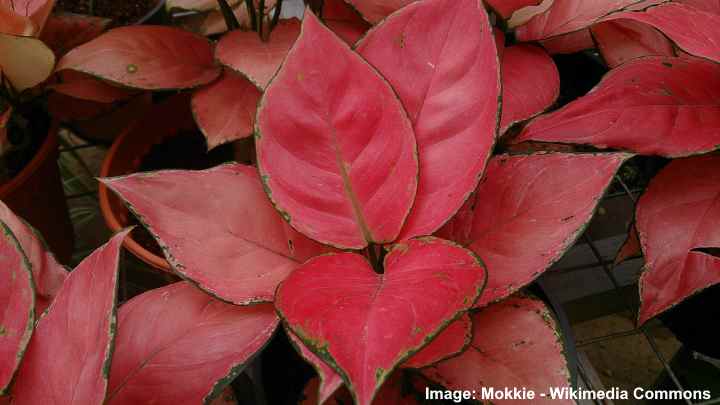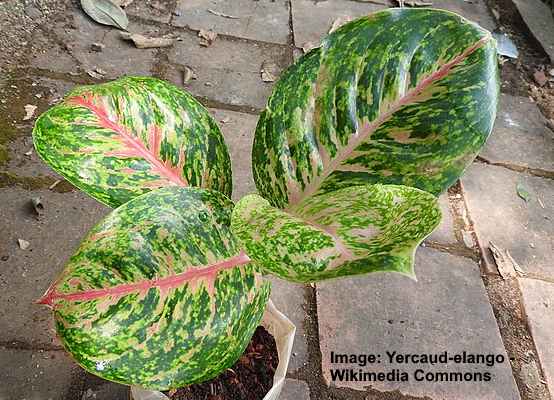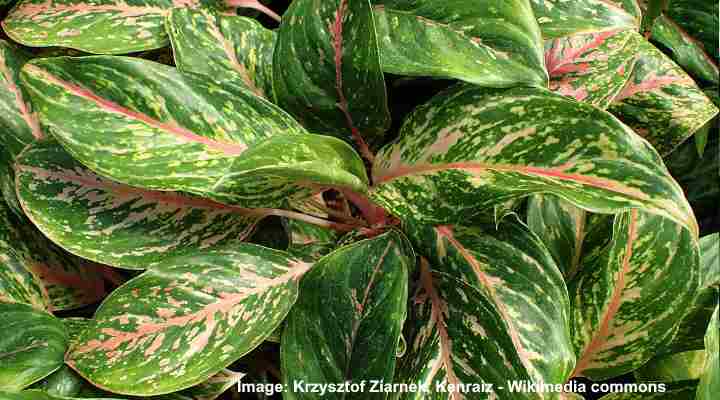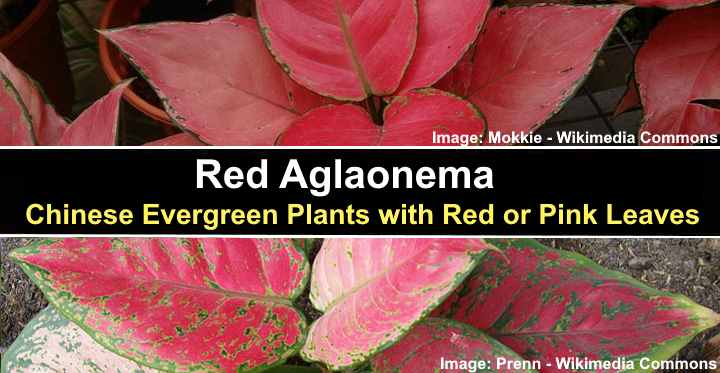Broadleaved tropical houseplants with huge green, red, and occasionally pink leaves are known as red aglaonemas. The red Aglaonema plants, sometimes known as Chinese evergreen plants, are cultivars of the flowering plant genus Aglaonema. ‘Siam Aglaonema,’ ‘Pink Dalmatian,’ ‘Ultra Pink,’ ‘Red Emerald,’ and ‘Super Red Star’ are some of the varieties of Aglaonema with pink and red leaves.
Indoor plants, such as Red Aglaonema, are simple to keep. They have dark red leaves that contrast with their light pink and green leaves. They are very hardy houseplants because of their medium-growth and tolerance of low light and drought.
Aglaonema comes in a variety of red hues, so finding a shade that matches your home interior design is easier than you think. This guide to red Aglaonema plants is for beginners. Pictures of red Aglaonemas will help you choose the perfect tropical indoor Aglaonema plant for your home, in addition to descriptions of Aglaonema’s broad, pointed colorful foliage.
About Red or Pink Aglaonema
The evergreen perennial genus Aglaonema is represented by cultivars with red or pink leaves. Species of Aglaonema grow in Asian tropical and subtropical rainforests, according to their native habitat. Aglaonema leaves are 4″ to 12″ (10 to 30 cm) long and 2″ to 4″ (5 to 10 cm) broad. They are lance- or heart-shaped and grow between 4″ and 12″. On vivid stems, the modest leaves alternate.
On red Aglaonema plants, there are several leaf pattern variations. Dark green glossy leaves contrast with the bright pink and red colors. Shiny green leaves with pink speckles are found in some Aglaonema cultivars. Broad, dark green leaves with black veins characterize other types of Aglaonemas. Olive green pointed leaves with pinkish-red margins are one of the most common red Aglaonema varieties, known as the ‘Siam Aurora.
It’s a good idea to remember that red Aglaonema plants are poisonous if you keep them at home. On their list of plants poisonous to dogs and cats, the ASPCA includes Chinese evergreen. Oral discomfort, drooling, and difficulty swallowing may be caused by ingesting portions of the plant.
Humans may also be allergic to the sap from Aglaonema plants, causing dermatitis and skin irritation. Red Chinese evergreen plants, on the other hand, are usually harmless if handled with caution in typical situations. Aglaonema plants are grown by some people because they believe the plants bring good fortune. The Lucky Plant is the name given to the Feng Shui equivalent of the auspicious Chinese Evergreen.
Another reason to maintain Aglaonema plants is that they are believed to be natural air cleansers, according to scientific investigations. One species of Aglaonema was discovered by scientists to be effective at removing harmful chemicals such as toluene, xylene, benzene, and formaldehyde.
Red Aglaonema Care
Grow the Chinese evergreen in low to medium indirect light to care for a red Aglaonema. In a loose, peat-based potting soil with excellent drainage, plant a red Aglaonema. When the soil is partially dry, these Chinese evergreens can be watered. In the spring, encourage bushier growth by trimming the red and pink foliage. In USDA zones 10 and 11, red Aglaonema plants flourish outside. Aglaonema plants prefer temperatures of at least 60°F (15.5°C) and humidity levels of at least 60% while indoors. Aglaonema plants thrive in most household situations.
There are a few things to consider when cultivating red Aglaonema at home. Even, mild temperatures are preferred by these tropical evergreens. As a result, they should be kept away from chilly and heated drafts. Red Aglaonemas have a medium growth rate and can survive in rich, fertile soil without additional feeding, despite the fact that you can apply fertilizer once every so often.
Red Aglaonema (Chinese Evergreen) Flower

Late-bloomer tropical plants like Red Aglaonema blossoms bloom in late summer. Aglaonema produces spathe flowers, like other arum plants in the Araceae family. A whitish spadix and a light green or colorful spathe make up the Chinese evergreen flowers.
Aglaonemas, on the other hand, aren’t often seen blooming indoors. If you notice that the Chinese evergreen flowers are developing, several plant experts recommend cutting them off. This is supposed to allow the plant to concentrate all of its energy on developing lovely red, pink, and green leaves.
Red Aglaonema – Red or Pink Aglaonema with Colorful Leaves
There are a variety of Aglaonema plants. However, some claim that the red and pink Aglaonema specimens are the most stunning. Lipstick-red designs on vivid green leaves, for example, can be found in the Siam Aurora. This plant has bright red leaves with thin green borders, and it’s known as the ‘Red Majesty.’ Aglaonema varieties with pointed lime-green leaves with pink and white splashes are also interesting.
Types of Pink and Red Aglaonema (With Pictures)
Let’s take a closer look at some of the most attractive red Aglaonema plants you might cultivate at home.
Aglaonema ‘Siam Aurora’

A gorgeous red aglaonema plant with crimson and green leaves is the Aglaonema ‘Siam Aurora. Greenish-black leaves with crimson borders make up the bulk of the large lanceolate leaves. There are also crimson plants with pinkish-red leaves and dots of dark, olive green designs throughout the garden.
Red Aglaonema ‘Siam Aurora’ should be maintained in medium, indirect light to ensure that it is cared for correctly. The reds and pinks on Chinese evergreen leaves stay vibrant when they get enough light. Although these plants may live in low-light, their leaves will lose their luster.
While growing the red “Siam Aurora” at home, it’s crucial to remember to water it thoroughly. Like other Aglaonema species, the Aglaonema ‘Siam Aurora’ dislikes soggy potting soil. As a consequence, you should only water the tropical plant when the top soil layer is dry.
‘Red Anjamani’ Aglaonema

The Aglaonema Red Anjamani features crimson heart-shaped or lance-shaped leaves with thin green borders. In the leaf blade of this red Aglaonema, you may see faint green veins. This small houseplant is popular because of its brilliant red leaves and patterned dark green markings.
The fact that this red Aglaonema cultivar maintains its bright colors all year is one of the reasons it is so popular. On a tabletop, bright windowsill, or office desk, the red leafy compact foliage looks stunning. The Aglaonema ‘Red Anjamani’ thrives in low light and may show more green designs on its crimson leaves.
Aglaonema ‘Lady Valentine’

The red, pink, and green leaves of the Aglaonema variety ‘Lady Valentine’ are oval to lanceolate. The red and pink leaves of the Chinese evergreen are particularly lovely. On the blade edges and veins, dark green patterns emerge. On some plants, the same Aglaonema might have pink or green leaves, as well as brilliant red and lime green leaves.
The pink and red leaf coloration of many Aglaonema species, like other plants, is affected by sunlight. To bring out the pink and red hues, it’s best to grow the plant in a sunny location. The leaves will become darker in low-light rooms. Provide consistent room temperatures of 60°F to 76°F (15.5°C to 24°C) and high humidity to help the red Aglaonema thrive.
Aglaonema ‘Two-Tone Moonstone’

The bright pink and light green leaves of the Aglaonema ‘Two-Tone Moonstone’ make it a dazzling show stopper houseplant. This Chinese evergreen has huge, pointed leaves that create a magnificent clump of bright foliage. Pink central ribs and loads of pink speckles adorn the lovely green leaves.
The vivid pink stems are another remarkable aspect of the Two-Tone Moonstone. This air purification system adds visual appeal to a home’s décor, brightening up any room. For optimal results, place the bushy pink and green Aglaonema in full sun.
‘Super Red Star’ Aglaonema

Just traces of green on the margins and tips distinguish Aglaonema ‘Super Red Star,’ which has spectacular bright red glossy leaves. The vibrant crimson leaves have a lustrous sheen that bounces natural or artificial light in a room. The variegation of the red Aglaonema leaves develops gradually, which is a fascinating feature.
Dark green leaves with crimson streaks down the midrib are becoming more common. The whole plant’s leaf turns bright red as the red variegation develops. This tropical cultivar may be referred to as a true red Aglaonema due to its excellent red color.
Aglaonema ‘Super Pink’

Another stunning colorful houseplant is Aglaonema ‘Super Pink,’ which grows in the tropics. Aglaonema leaves are practically entirely pink, with the exception of a few streaks. Some dark green dots or specks might be seen on the pointed lance-shaped bright pink leaves.
Pure pink leaves are seen in certain cultivars, though. The compact growth of this uncommon pink houseplant makes it ideal for adding visual appeal to contemporary designs. On a table, desk, or bright windowsill, the potted pink Aglaonema plant looks amazing.
Aglaonema ‘Pink Splash’

Aglaonema ‘pink splash’ is a compact, bushy Aglaonema plant with pink and green leaves. The red Aglaonema cultivar has large, glossy green pointed leaves with pink streaks, as the name implies. The cultivar and the amount of sunlight it receives determine the level of pink variegation on the leaves. The Aglaonema variety ‘Pink Splash’ has pink colors ranging from light pink to dusty pink and dark pink, with a range of pale to heavy coloration.
The leaf color of the Aglaonema Chinese evergreen cultivar looks like the Pink Splash, but it is less vibrant. In contrast to light green and pink leaves, the red ruby has dark green leaves with bright red markings.
‘Red Peacock’ Aglaonema

The Aglaonema ‘Red Peacock’ has broadleaves with green, pink, and yellow variegation that are spectacular. These leaves seem to be the broadest of all red Aglaonema cultivars. The lime green leaves with brilliant pink veins curving out from the core midrib are among the most attractive Aglaonema leaves.
The creamy-yellow speckles and splashes on the leaves give the brilliant foliage. Only water the tropical plant when the top 2″ (5 cm) of potting soil is dry, maintain it in a humidified environment between 65°F and 76°F (15°C and 24°C), and keep it in temperatures between 65°F to 76°F (15°C to 24°C).
Aglaonema ‘Golden Passion’

Oblong-ovate light green leaves with pink midribs and veins and yellow variegation distinguish the Aglaonema cultivar ‘Golden Passion. The overall yellowish-green color of these Aglaonema leaves. The leaf undersides, on the other hand, are mostly dark pink.
Moreover, until the green, yellow, and pink leaves unfurl, new leaf development appears like a pink tube. The Golden Passion has bright pink stems, like other varieties of Aglaonema plants.
Aglaonema ‘Sparkling Sarah’

Aglaonema ‘Sparkling Sarah,’ a bushy plant with green, pink, and yellow variegation, is an exotic Aglaonema. Pink specks adorn the midribs and veins of the glossy lime green rounded ovate leaves. The pink splashes might cover most of the green leaves depending on how much light this cultivar receives.
The bright pink veins are a surprise feature of the Sparkling Sarah. The yellow and green tropical leaves are contrasted well by this lovely pink pastel shade. This low-light houseplant thrives in households and workplaces, making it a great choice. Only water the soil when it’s 50% dry, and place in moderate light to allow the ‘Sparkling Sarah’ cultivar to flourish.
Aglaonema ‘Emerald Holiday’

The lanceolate leaves of the Aglaonema plant have lush, glossy green surfaces with stunning crimson or pink veins. Despite the fact that this Chinese evergreen isn’t red, its pinkish-red stems and veins give it a striking look. The Aglaonema ‘Emerald Holiday’ is a great houseplant for darker rooms because it has blacker green leaves. Pots are ideal for growing the bushy, clumping compact growth. The Emerald Holiday is a great bathroom plant because of its fondness for humid, warm conditions.
